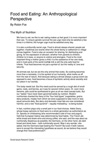Food and Eating: An Anthropological Perspective
– By Robin Fox
Tables and Table Manners
Not knowing how to eat 'properly' is universally a sign of outsider status. Proper eating includes the kind of food used, the way of preparing it, the manner of serving it, and the way of eating it. The intricacies of the tea ceremony are known only to experienced Japanese; social climbers in the West can be spotted immediately by their inability to master the details of place settings; "using the wrong fork" is an offense as grave as spitting in public. Since anyone wishing to integrate himself into a group must eat with it, there is no surer way of marking off those who are in and those out than by food etiquette. Dipping with hands into a communal dish is de rigeur in some cultures, abhorrent in others. Shovelling food into the mouth with a fork would be seen as the height of indelicacy by some; the absence of forks as the height of barbarity by others. Fingers may have been made before forks, but ever since Catherine (and Marie) de Medici brought these essential tools for noodle eating from northern Italy to France, the perfectly useful finger has been socially out, except for fruit and cheese. It took the elaborate dining habits of the upper classes to refine the use of multiple forks (as well as knives, spoons, and glasses).
The timing of eating shows up class differences. In the past, as in the novels of Jane Austen, for example, the upper classes breakfasted late (about 10 o’clock), as befitted their leisure status. (This distinguished them from the lower orders, who eat very early before going off to work.) They had perhaps an informal lunch of cold meats, but the next main meal was dinner, which was eaten anywhere between five and seven, depending on the pretensions of the family. A light supper might be served before bedtime. The lower orders, meanwhile, would be eating a light midday meal and then a hearty "tea" after the day’s work was done, with again a supper before bed. The importance of "lunch" as a main meal came later from the business community, and "dinner" was pushed back into the evening, with supper more or less abolished. The lower orders continued to make midday "dinner" and "high tea" major meals, and since dinner was pushed later for the middle classes, "tea" became an institution around four o’clock. There is no nutritional sense to the timing of eating. It could be done differently. The late breakfast was primarily a sign of status and nothing else; Jane Austen’s characters always had to kill time in some way before breakfasting, and these were good hours in which to advance the plot. In France, the enormous midday meal, with its postprandial siesta, is what the day revolves around. The entire country comes to a stop and wakes up again between three and four.
The order in which foods are eaten, which really does not matter, becomes highly ritualistic: Soup, fish, poultry, meat, dessert (which echoes the process of evolution) becomes a standard. Sweet should not be eaten before savory, and rarely (in France never) with. The French eat salad after the main dish, the Americans rigidly before; the English, to the disgust of both, put it on the same plate as the (cold) meat. In the East, it is more common to serve all the food together, often in communal dishes, and allow a wide sampling of different items. In the more individualistic West, place settings are rigidly set of from each other, and so are "courses." The serving of wine with food becomes even more rigidly a matter of protocol, and operates to mark off differences of status within classes: those who "know" wine and those who do not. Classes in "corporate health" in the United States now include sessions on "How to Read a Wine Label." The rationale is that without such knowledge corporate executives may be subject to "stress," which would impair their performance. Foreign foods tend to be shunned by the working classes, but among the upper-middle and upper they become items of prestige. A knowledge of foreign food indicates the eater’s urbanity and cosmopolitanism. Until recently, being conversant with foreign food was a privilege of those who could afford to travel, but now the knowledge has been democratized by cheap travel and television. Julia Child taught the aspiring middle classes how to be "French" cooks, and now TV abounds with every kind of cooking course. Publishers often find their cooking list to be their most lucrative, and cookbooks of all nations now crowd the bookstore shelves. When Joy of Sex was written, it deliberately took its title from the hugely successful Joy of Cooking - which tells us something. While a lot of this can perhaps be attributed to a genuine pleasure in new tastes, a lot more can probably be accounted for by the aura of sophistication that surrounds the food "expert." The very word "gourmet" has become a title of respect like "guru" or "mahatma." Vast changes have occurred, for example, in English eating habits, with extended travel in Europe. Ethnic identifications in food have not by any means disappeared, and the French do not, by and large, eat fish and chips; the English have not taken wholeheartedly to escargot or octopus. But spaghetti no longer comes exclusively in cans for the English. Even so, a relative conservatism of food habits persists in all countries, particularly with the lower-middle and working classes.


